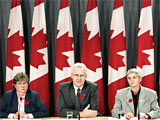Entered into the database on Tuesday, November 01st, 2005 @ 20:55:10 MST
One day after officials revealed wild birds carrying the H5 strain
of avian flu virus have been found in Canada, the nation's chief public health
officer is urging Canadians not to panic. "The first thing to know is that it's a huge leap for a bird virus
to become a human virus that spreads efficiently in people," said Dr. David
Butler-Jones, appearing on CTV's Canada AM. "That's just a tremendous leap and very difficult and we likely would actually
be able to watch that with the surveillance and have better preparation for it,"
he said. In fact, Butler-Jones said that avian flu viruses have been discovered before. "This really just documents more clearly what we've known for a long time
-- that there's a range of avian viruses and that we do see them in all parts
of the world, including in North America." "In terms of the one that most people are worried about, the H5N1 that
we see in Southeast Asia, the Americans have been doing surveillance in Alaska
-- that's where it would come across." Meanwhile, a stakeholder is also reassuring that Canada is in a good position
to stop an outbreak of avian flu in commercial poultry stocks. The Canadian Press reported that Chicken Farmers of Canada General Manager
Mike Dungate said Canadians learned lessons the hard way last year when testing
indicated that the avian flu found on a goose and duck farm near Abbotsford,
B.C. was not the H5 variety. Instead, the 37,000 geese on the Fraser Valley Duck and Goose Ltd. farm were
exposed to the H7N3 strain of avian influenza virus. The outbreak caused no
major human health problems, but forced the culling of some 16 million poultry. Dungate noted that the outbreak, which devastated the industry in the Fraser
Valley, prompted the tightening of controls on biosecurity and improved communication
with federal officials. On Monday, the Canadian Food Inspection Agency announced that several wild
waterfowl in Quebec and Manitoba have tested positive for H5 flu viruses. However,
the chance of the strain being the lethal H5N1 type is "likely fairly remote,"
said Jim Clark of the CFIA. Health officials in Winnipeg conducting tests on the H5-infected birds won't
know whether they have H5N1 until mid-week. Even if the Canadian birds are carrying the H5N1 virus, it does not mean they
are necessarily related to the viruses behind the poultry outbreaks in Southeast
Asia. That strain is behind the avian flu problem growing in Asia, where more than
60 people have died of H5N1 infection transmitted from poultry. With the strain crawling through Europe as migrating fowl fly westward, there
are mounting fears that the virus could mutate into one that can easily spread
among humans and thus prompt a global pandemic.

